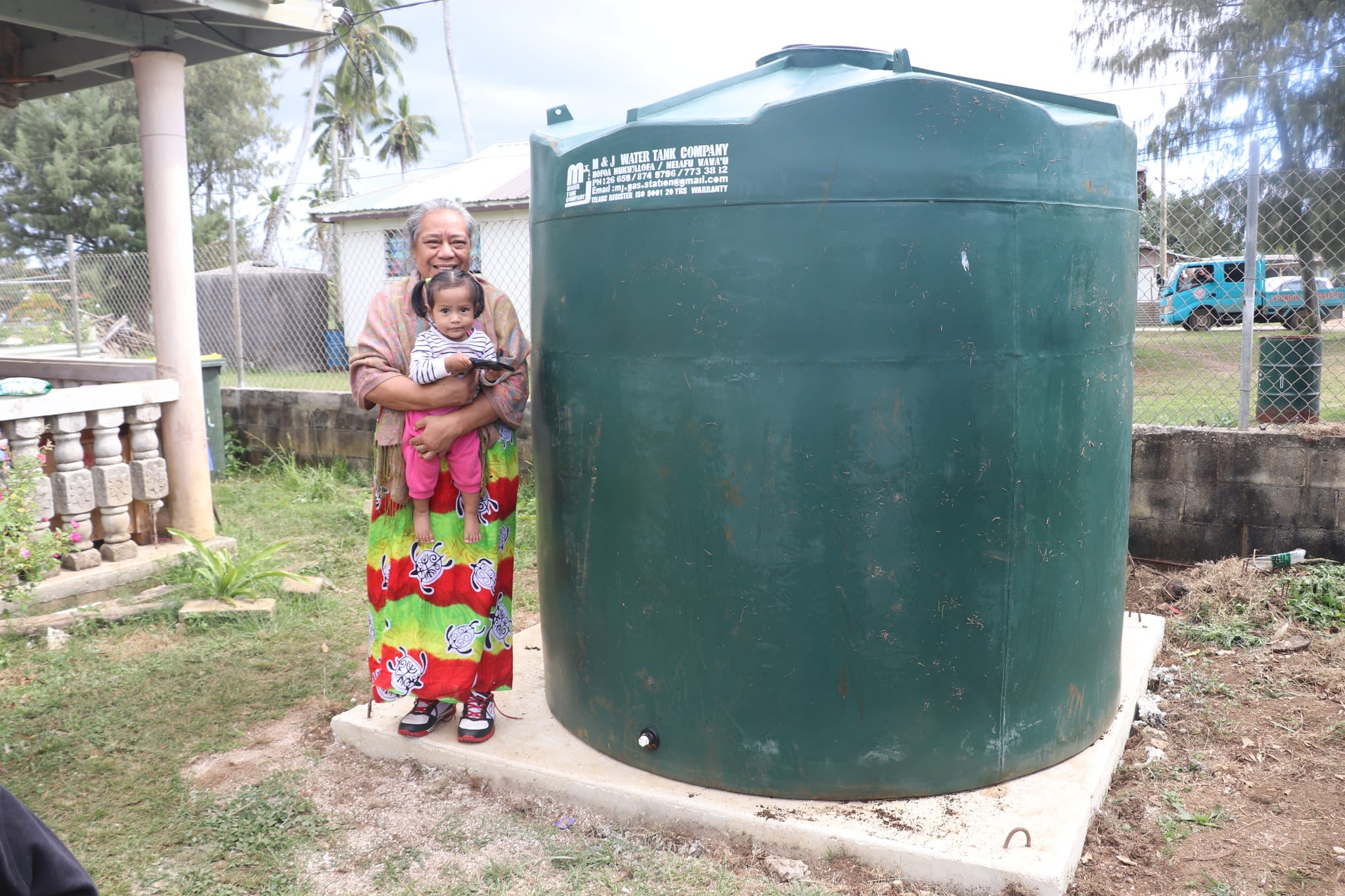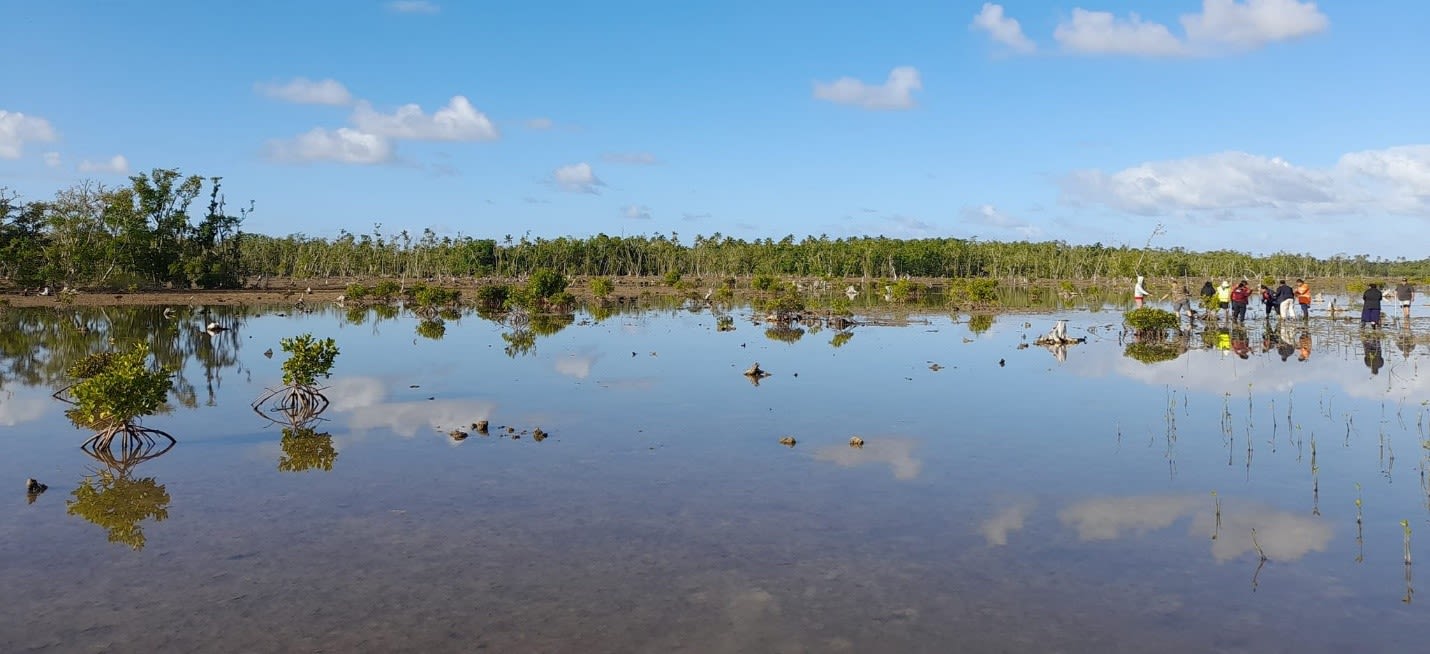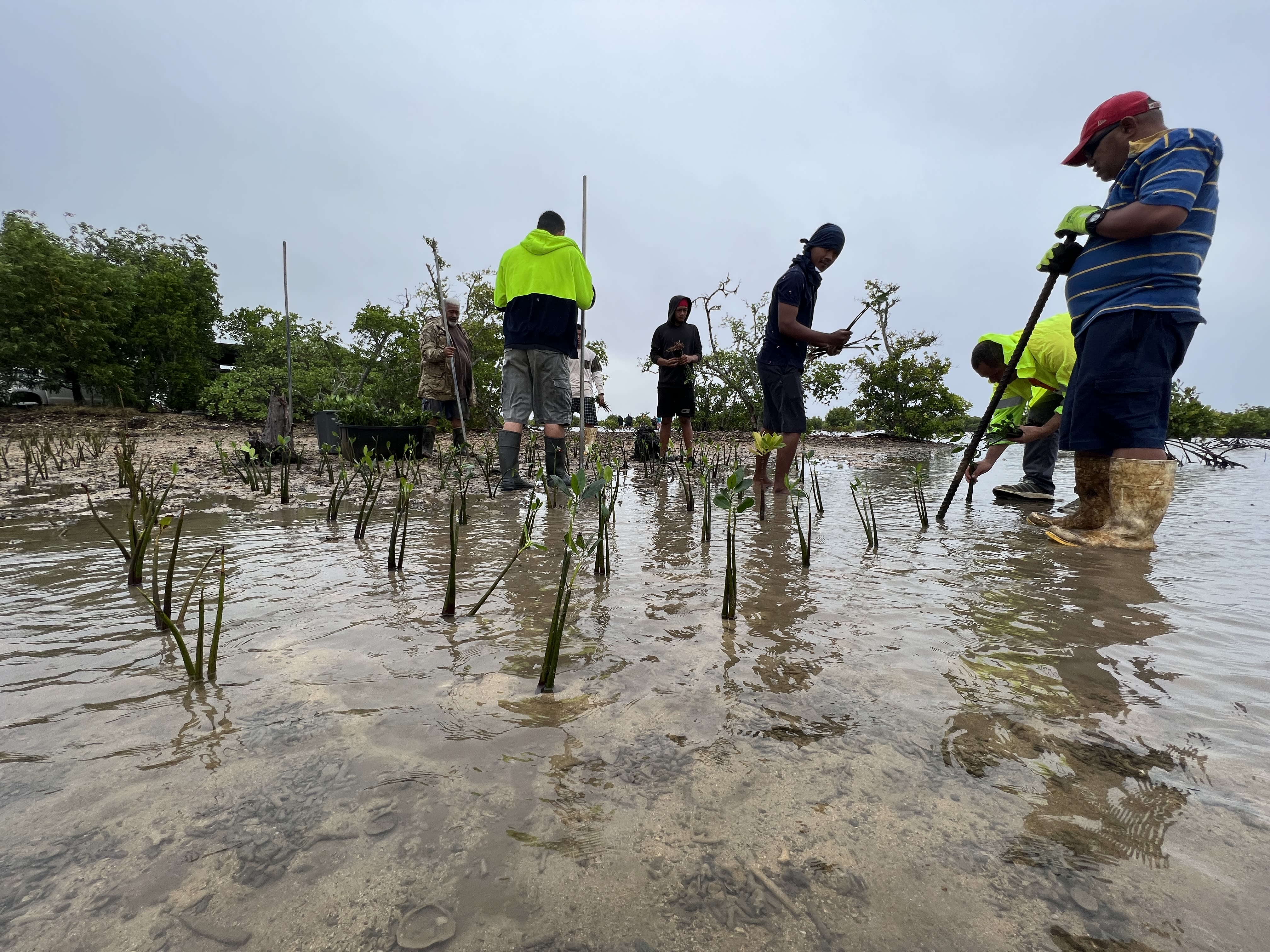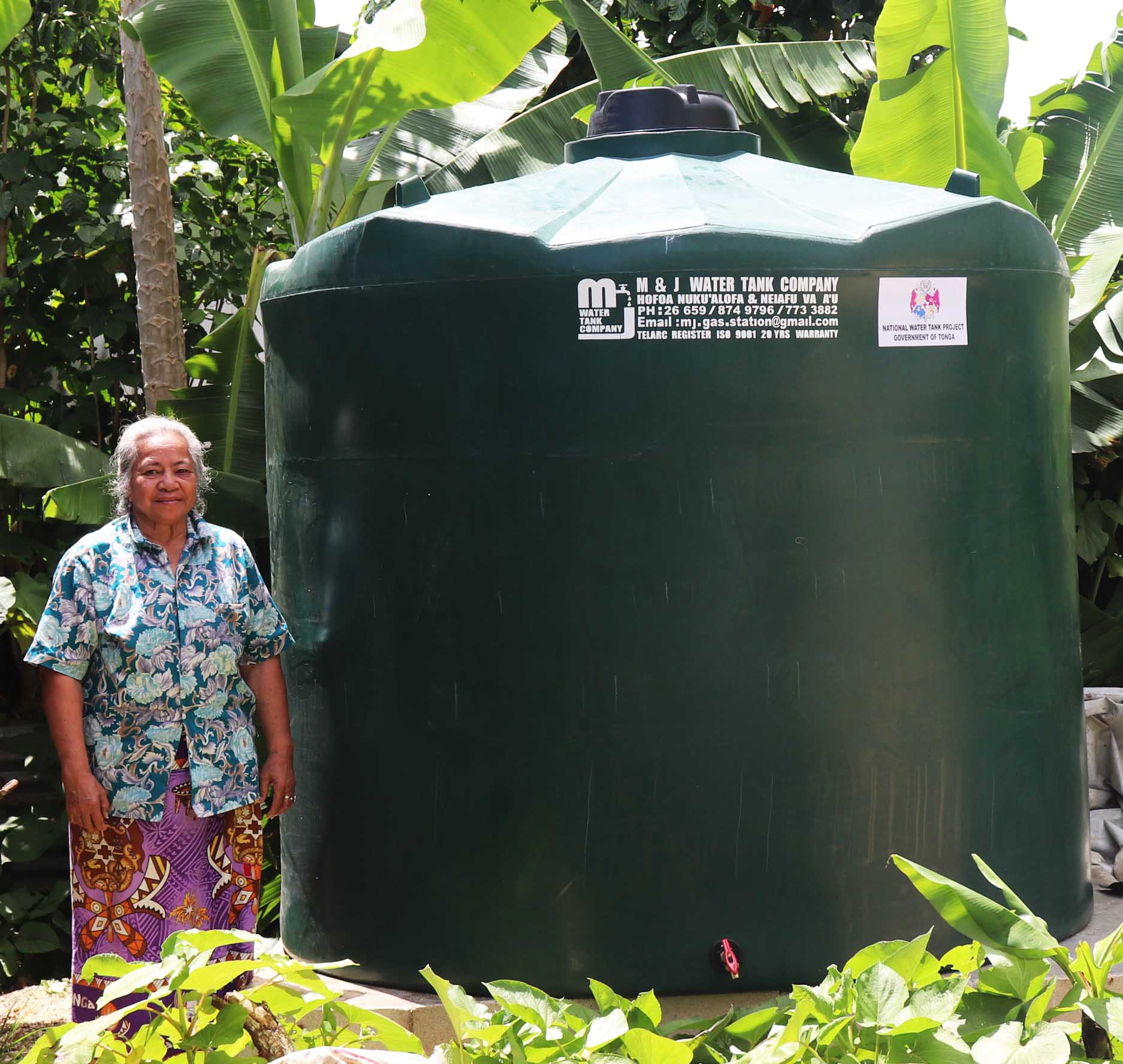Sustaining Hope and Harvesting Rainwater
Tonga builds resilience in face of climate crisis


Tonga was the first Pacific country to develop a Joint National Action Plan (JNAP) on Climate Change and Disaster Risk Management in 2010, which served as the island nation’s national adaptation plan (NAP). Tonga is now implementing the second iteration of its NAP, the JNAP 2. Tonga’s 2020 Second Nationally Determined Contribution (NDC) built on the JNAP 2, clarifying how the country would achieve adaptation goals related to several targets set out in the JNAP 2.
The Green Symphony
Deep in the heart of Tonga's largest mangrove forest, located on the northern coast of the main island of Tongatapu, eight staff members from Tonga’s Department of Climate Change gather on a chilly tropical morning. Usually, their work is in the office dealing with proposals and project administration, but today, they are poised for a different kind of mission. As the tropical sun begins its ascent, they are united under the banner of the "1 Million Trees Goal," a momentous undertaking shared with the Department of Environment, the Ministry of Agriculture, and several organizations in Tonga that are also lending their support.
In the lead is Aloisio Fifita, the head of division for the Ozone Division in the Department of Climate Change. He marshals his troops with the task of planting 3,800 mangrove trees over the next three days—a major stride toward Tonga’s 1 Million Trees Goal as part of its nationally determined contribution and the achievement of seeing “30 per cent of land in Tonga utilized for agroforestry or forestry,” a target under Tonga’s JNAP 2.
Amid the rich mangroves, there is a tranquil harmony, a song sung here for millions of years. The hush of the forest’s whisper is broken by occasional splashes of fish, the rustle of mud crabs, and sometimes the flapping of the purple swamphen.

Community groups from the nearby villages are working to restore Tonga’s largest mangrove forest. Photo: Viliami Takau
Community groups from the nearby villages are working to restore Tonga’s largest mangrove forest. Photo: Viliami Takau
Away from their desks, the team plunges their hands into the loamy soil. Each tree is not only a testament to their collective vision but an act of reverence for their ancestral home country. “A million mangrove trees could easily fit into this area alone,” says Aloisio. “It is just a matter of action at this point.”
High above the watery landscape hums a drone from Tonga’s National Emergency Management Office. The camera captures the vast open parts of the mangrove forest that are able to sustain growth.
An hour passes by, and the thudding sound of clonking sticks penetrates through the mangrove forest—a familiar sound across the kingdom that signifies the traditional hand-manufacturing of Tapa cloth by women. “Behind those trees lies the village of Puke,” says Aloisio. “Planting mangroves here won’t just build the biodiversity of the area, it will create a safety buffer for those villagers from storm surges.”
The Department of Climate Change and the Department of Environment have split the number of trees to each take on 500,000 toward their goal of 1 million trees planted by the end of 2023.

Community groups from the nearby villages are working on restoring Tonga's largest mangrove forest. Photo: Viliami Takau
Community groups from the nearby villages are working on restoring Tonga's largest mangrove forest. Photo: Viliami Takau
Tongan Communities Build Water Resilience
In the azure waters of the South Pacific, a tale of resilience and cooperation is unfolding as Tonga’s Department of Climate Change, with funding from Korean Aid, works to safeguard vulnerable communities from climate change.
Tonga, a breathtaking archipelago of lush green landscapes and pristine beaches, has long grappled with the impacts of drought and water scarcity, particularly during the arid months from May to October. The National Water Tank Project is underway on the main island of Tongatapu, which experienced water shortages in 2023.
Recently, a glimmer of hope emerged as the Department of Climate Change announced the delivery of 300 much-needed water tanks, funded by Korean Aid. With the ambitious goal of bolstering the resilience of Tonga's communities, this initiative has already begun to transform the lives of those most affected by climate change.

Department of Climate Change in Tonga announced the delivery of 300 water tanks funded by Korean Aid. Photo: Viliami Takau, Department of Climate Change, Tonga
Department of Climate Change in Tonga announced the delivery of 300 water tanks funded by Korean Aid. Photo: Viliami Takau, Department of Climate Change, Tonga
Among the beneficiaries are the communities of Vava’u, a picturesque island group nestled in the heart of the Tongan archipelago. Vava’u, like many other regions in Tonga, has endured its share of hardships, grappling with parched lands and water shortages during the relentless dry spells. With 40 water tanks allocated to Vava’u, the distribution was carefully coordinated to reach the constituencies of Vava’u 14 and Vava’u 16, areas that have borne the brunt of climate-related disasters in recent times.
At the forefront of this exercise is Tonga’s Department of Climate Change and its national adaptation plan, as submitted to the UN Framework Convention on Climate Change (UNFCCC): one of the JNAP 2’s target is to achieve “water security through integrated management and conservation.” By focusing on enhancing resilience and reducing vulnerability to climate-induced disasters, their efforts offer a beacon of hope to the Pacific nation.
The monitoring activities in Vava’u, carried over from 2022 to 2023, show encouraging results. Villages and districts have embraced the arrival of the water tanks, recognizing the critical role they play in securing their livelihoods and sustenance during the unforgiving dry seasons. According to the technical officer in the Department of Climate Change, Vava’u, Ms. Ma’ata Kata, the last monitoring activities showed that 92.5% of these households had already completed the necessary foundations for the tank stand, demonstrating the need for improved water supply in the communities.
But beyond the numbers and statistics lies a deeper connection to nature—a shared understanding of the pressing need to protect their land and seas, handed down through generations. The sight of these sturdy water tanks dotting the landscape is a tangible symbol of solidarity, where international aid and local spirit meet in the face of adversity.
In this corner of the Pacific, where the blue of the sea meets the blue of the sky, a shared commitment to safeguarding the Earth’s fragile ecosystems unites us all. The descendants of masterful navigators now find themselves on a voyage of discovery, hope, and resilience amid the rising tide of climate change.

The Department of Climate Change has started the roll out of water tanks to households across Tonga. Photo: Viliami Takau, Department of Climate Change, Tonga
The Department of Climate Change has started the roll out of water tanks to households across Tonga. Photo: Viliami Takau, Department of Climate Change, Tonga

Monitoring water tanks at Tu’anekivale village. Photo: Viliami Takau, Department of Climate Change, Tonga
Monitoring water tanks at Tu’anekivale village. Photo: Viliami Takau, Department of Climate Change, Tonga

The National Water Tank Project is currently underway on the main island of Tongatap. Photo: Viliami Takau, Department of Climate Change, Tonga
The National Water Tank Project is currently underway on the main island of Tongatap. Photo: Viliami Takau, Department of Climate Change, Tonga
Credits
Photos and stories by: Viliami Takau, Department of Climate Change, Ministry of Meteorology, Energy, Information, Disaster Management, Environment, Climate Change and Communications (MEIDECC), Tonga.
© March 2024, International Institute for Sustainable Development
Published by the International Institute for Sustainable Development.
This publication is licensed under a Creative Commons Attribution-NonCommercial-ShareAlike 4.0 International License.

